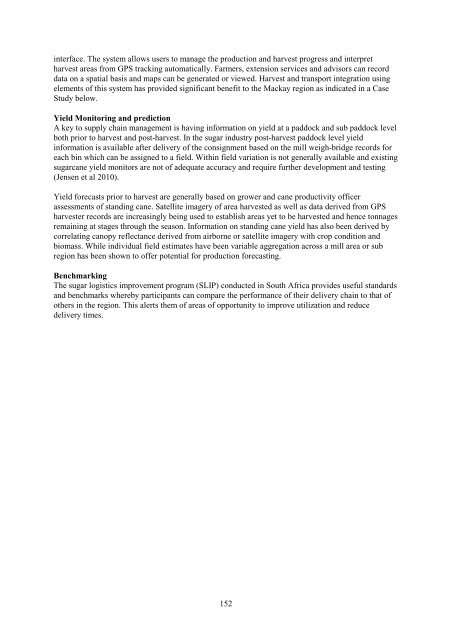Download (4Mb) - USQ ePrints - University of Southern Queensland
Download (4Mb) - USQ ePrints - University of Southern Queensland
Download (4Mb) - USQ ePrints - University of Southern Queensland
Create successful ePaper yourself
Turn your PDF publications into a flip-book with our unique Google optimized e-Paper software.
interface. The system allows users to manage the production and harvest progress and interpret<br />
harvest areas from GPS tracking automatically. Farmers, extension services and advisors can record<br />
data on a spatial basis and maps can be generated or viewed. Harvest and transport integration using<br />
elements <strong>of</strong> this system has provided significant benefit to the Mackay region as indicated in a Case<br />
Study below.<br />
Yield Monitoring and prediction<br />
A key to supply chain management is having information on yield at a paddock and sub paddock level<br />
both prior to harvest and post-harvest. In the sugar industry post-harvest paddock level yield<br />
information is available after delivery <strong>of</strong> the consignment based on the mill weigh-bridge records for<br />
each bin which can be assigned to a field. Within field variation is not generally available and existing<br />
sugarcane yield monitors are not <strong>of</strong> adequate accuracy and require further development and testing<br />
(Jensen et al 2010).<br />
Yield forecasts prior to harvest are generally based on grower and cane productivity <strong>of</strong>ficer<br />
assessments <strong>of</strong> standing cane. Satellite imagery <strong>of</strong> area harvested as well as data derived from GPS<br />
harvester records are increasingly being used to establish areas yet to be harvested and hence tonnages<br />
remaining at stages through the season. Information on standing cane yield has also been derived by<br />
correlating canopy reflectance derived from airborne or satellite imagery with crop condition and<br />
biomass. While individual field estimates have been variable aggregation across a mill area or sub<br />
region has been shown to <strong>of</strong>fer potential for production forecasting.<br />
Benchmarking<br />
The sugar logistics improvement program (SLIP) conducted in South Africa provides useful standards<br />
and benchmarks whereby participants can compare the performance <strong>of</strong> their delivery chain to that <strong>of</strong><br />
others in the region. This alerts them <strong>of</strong> areas <strong>of</strong> opportunity to improve utilization and reduce<br />
delivery times.<br />
152
















